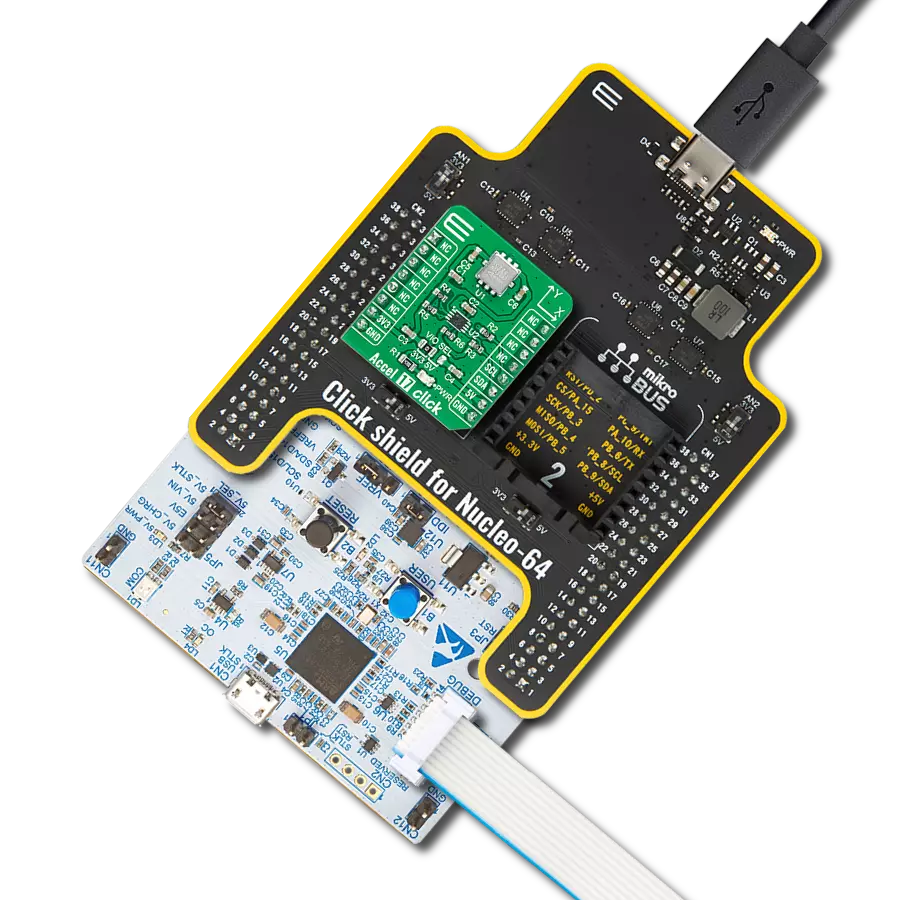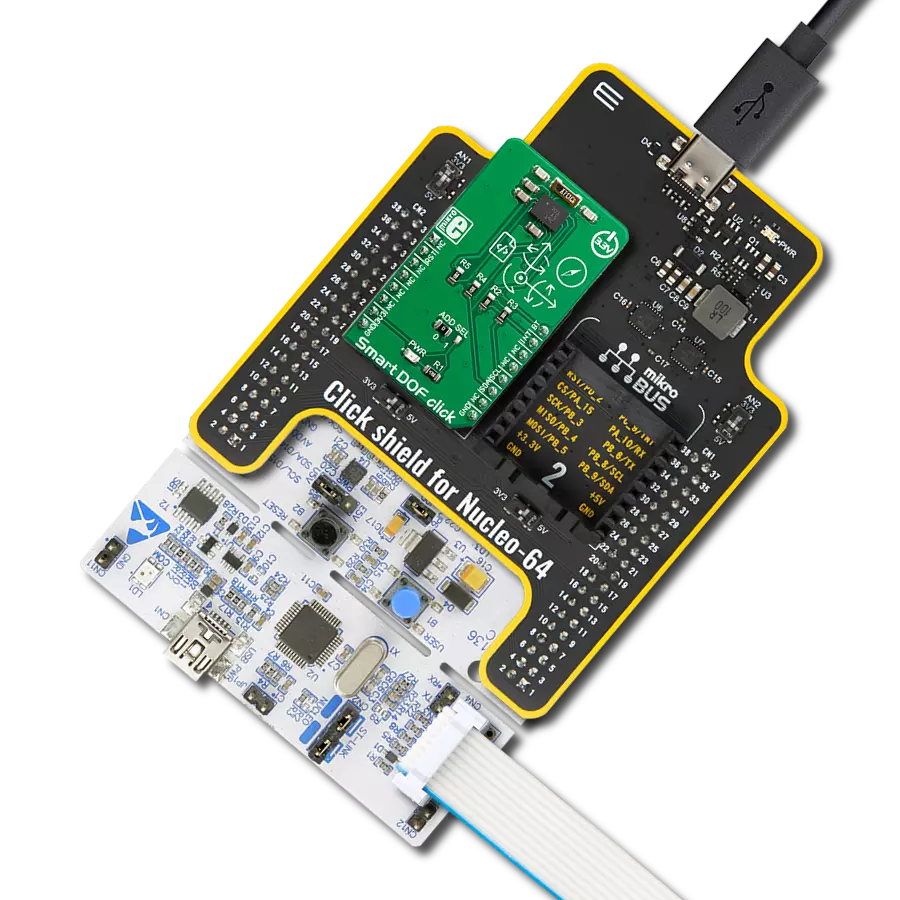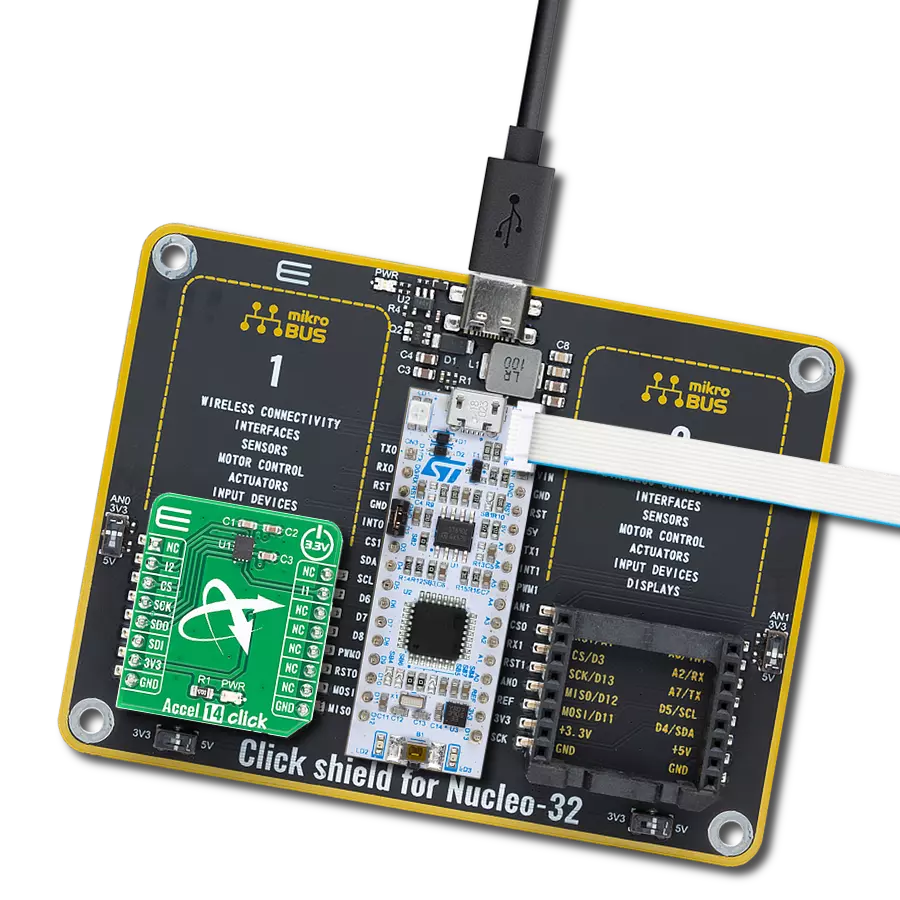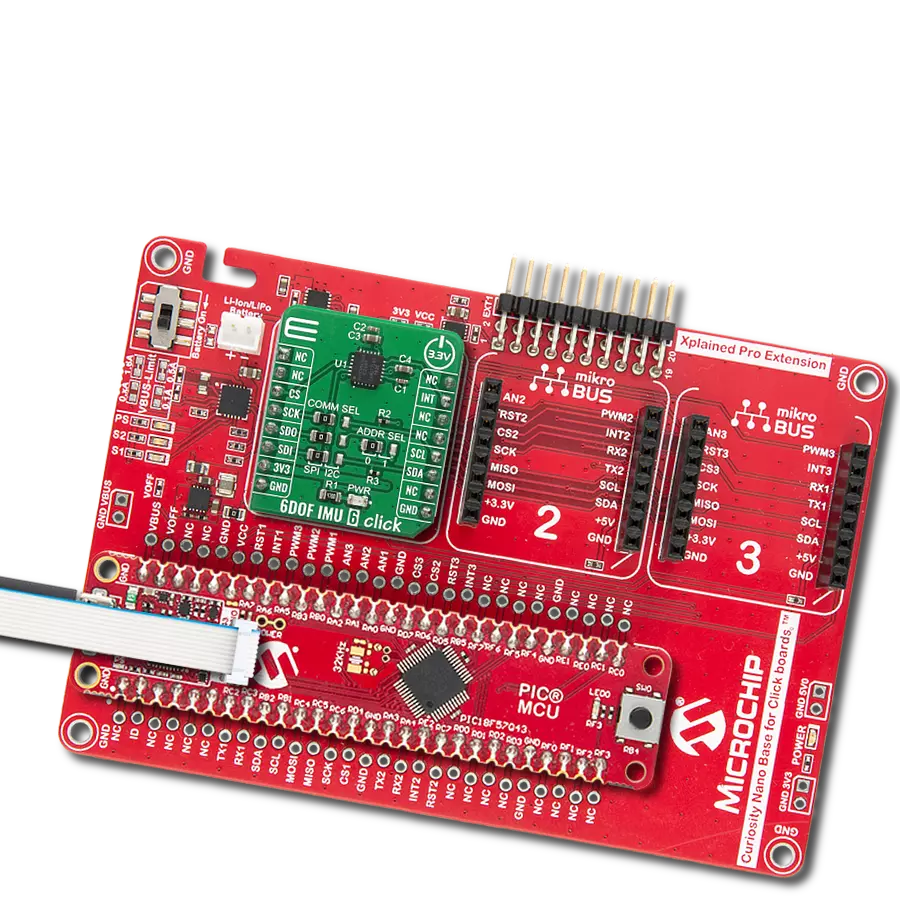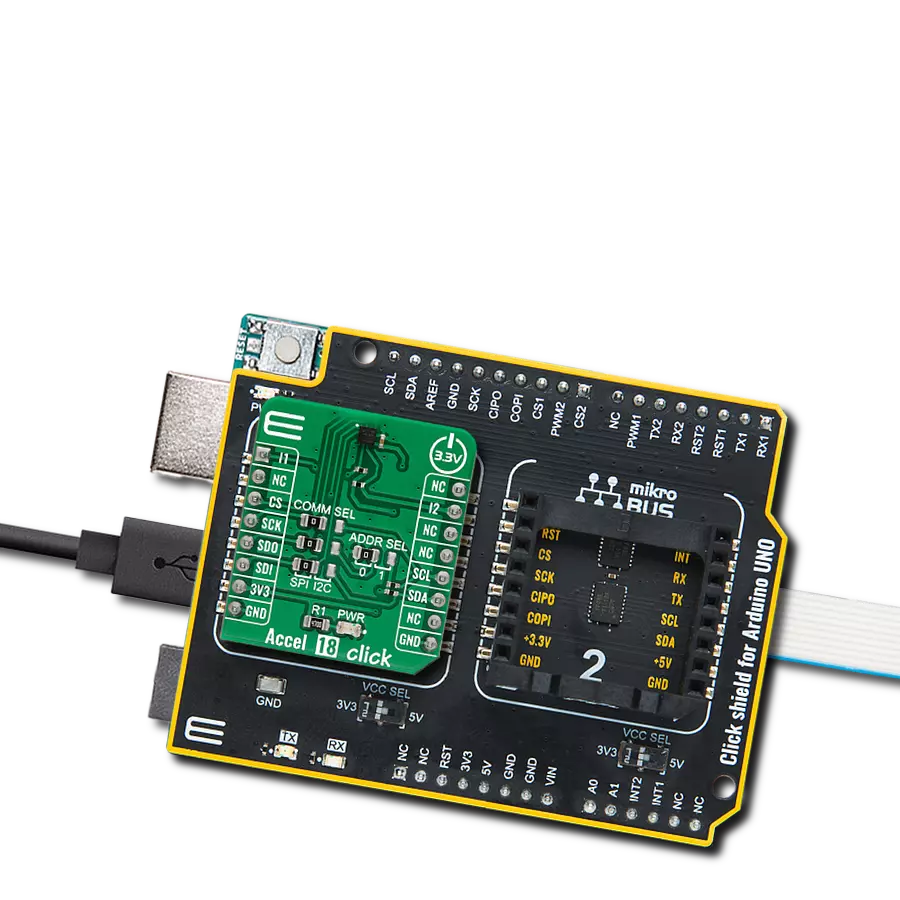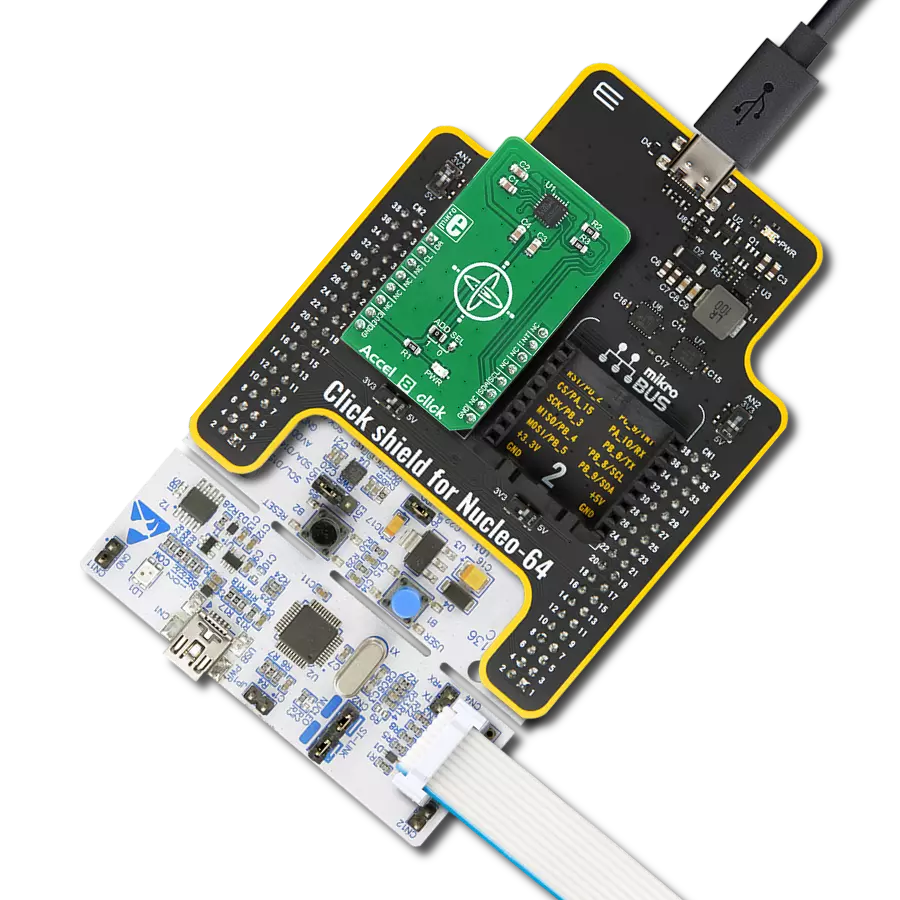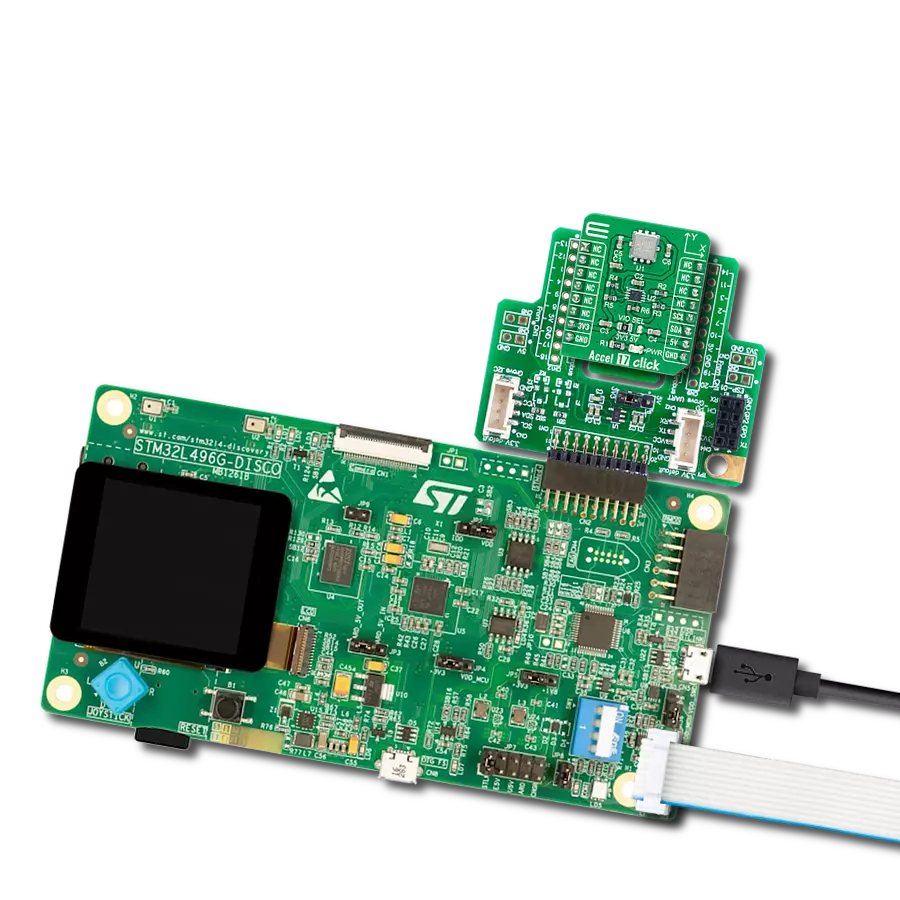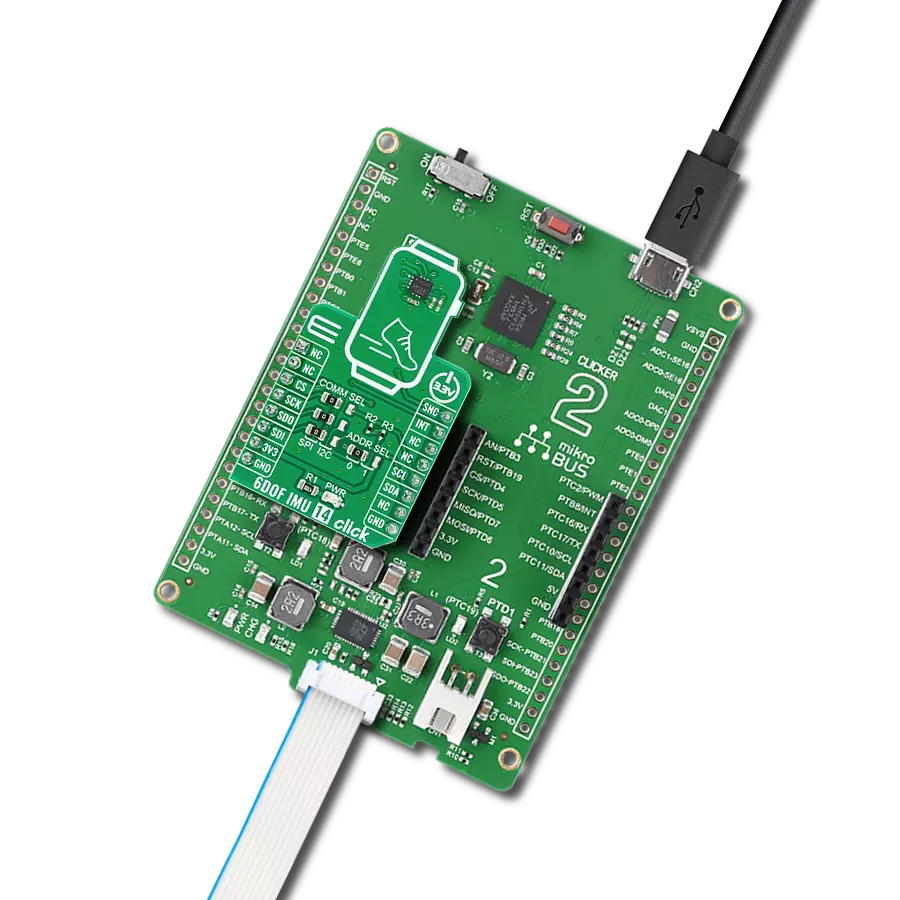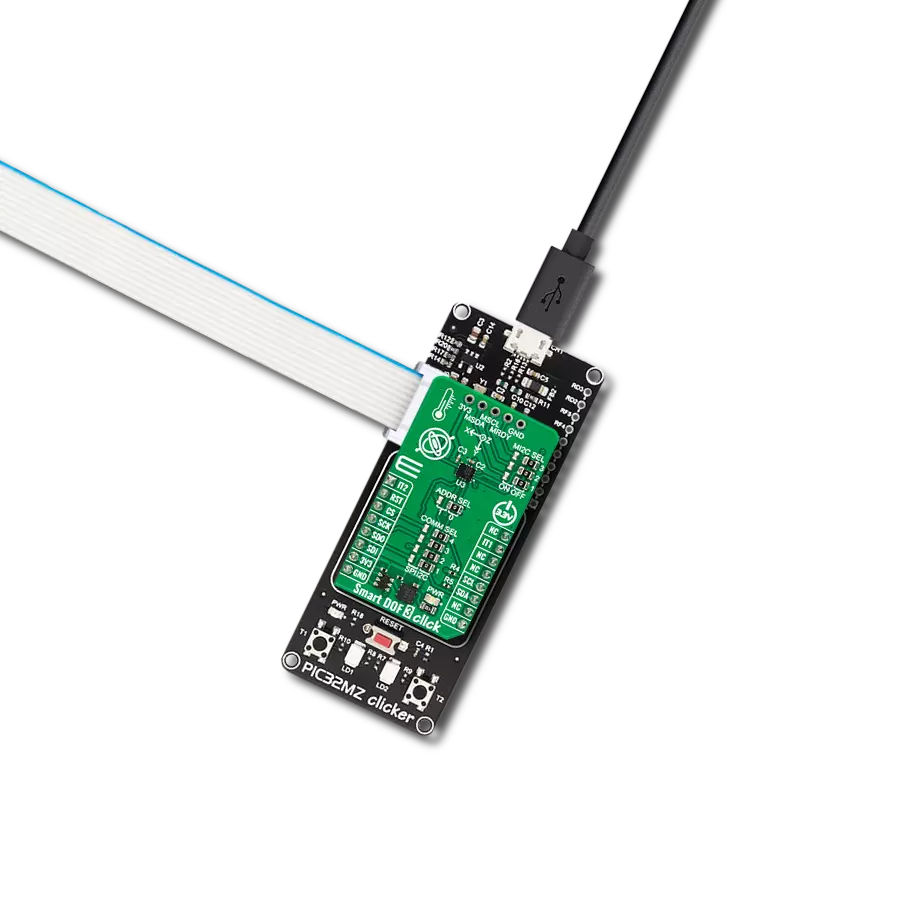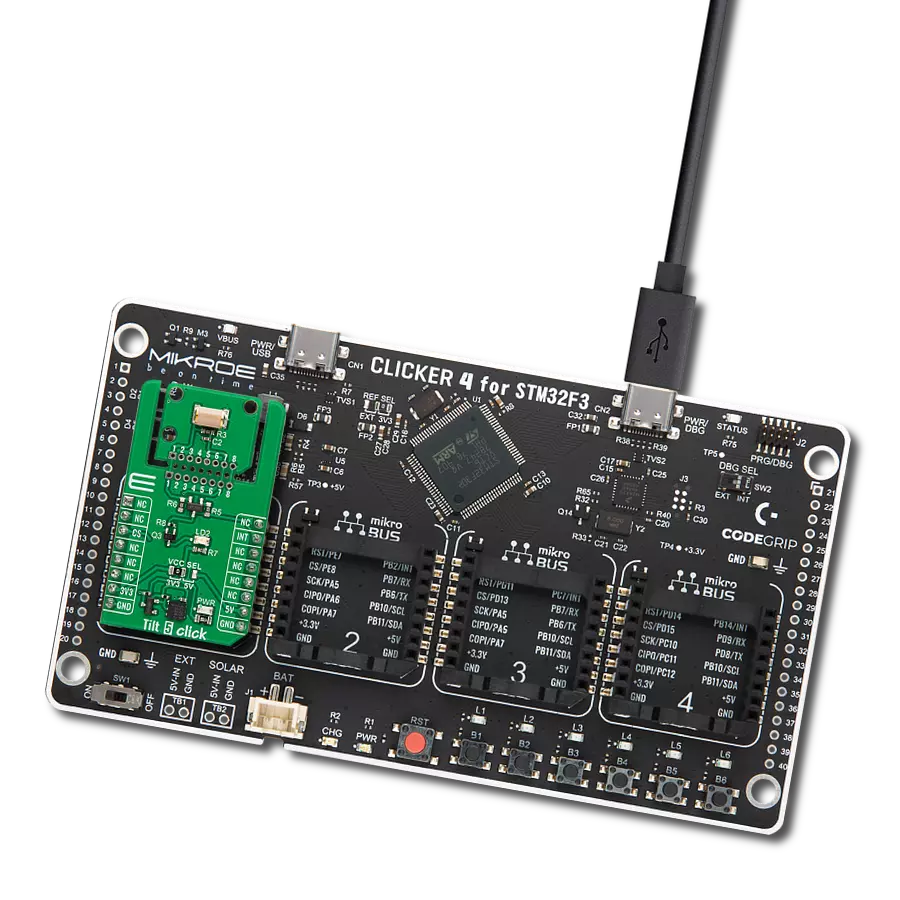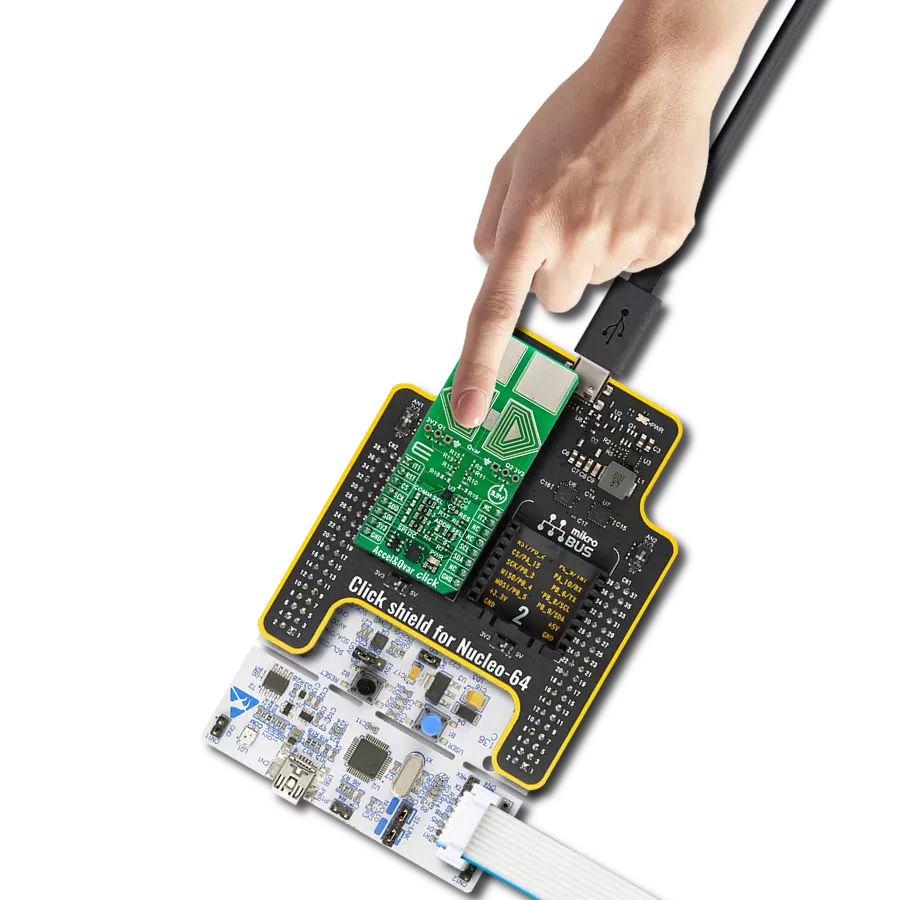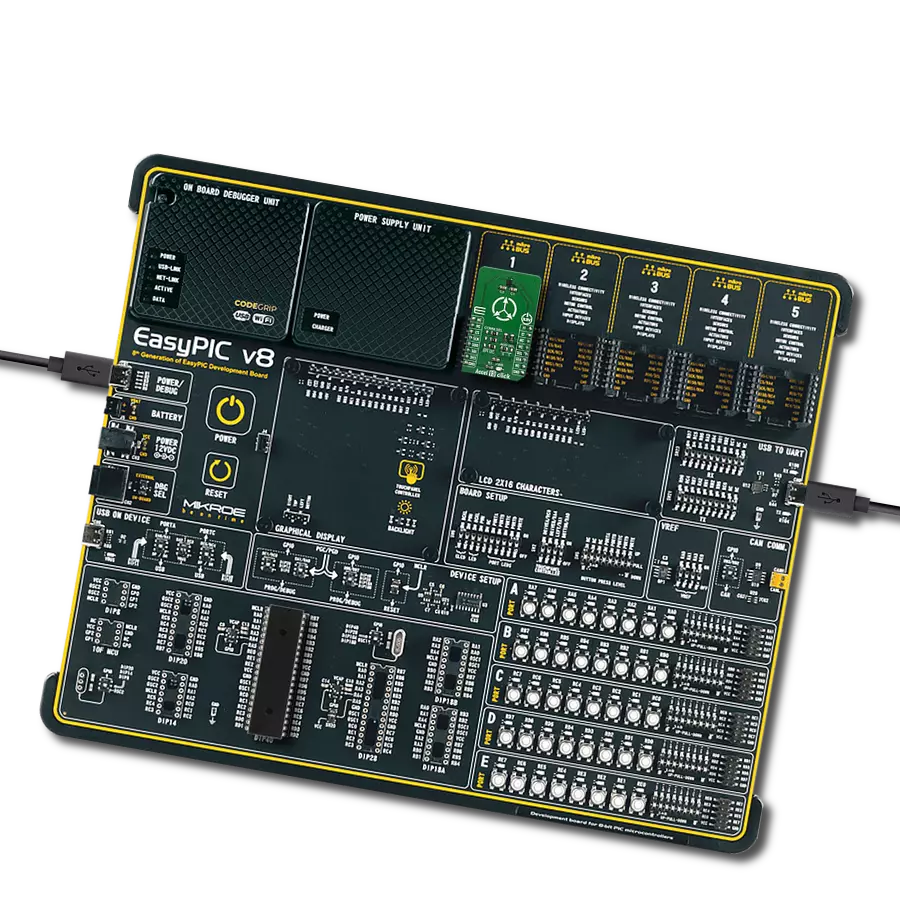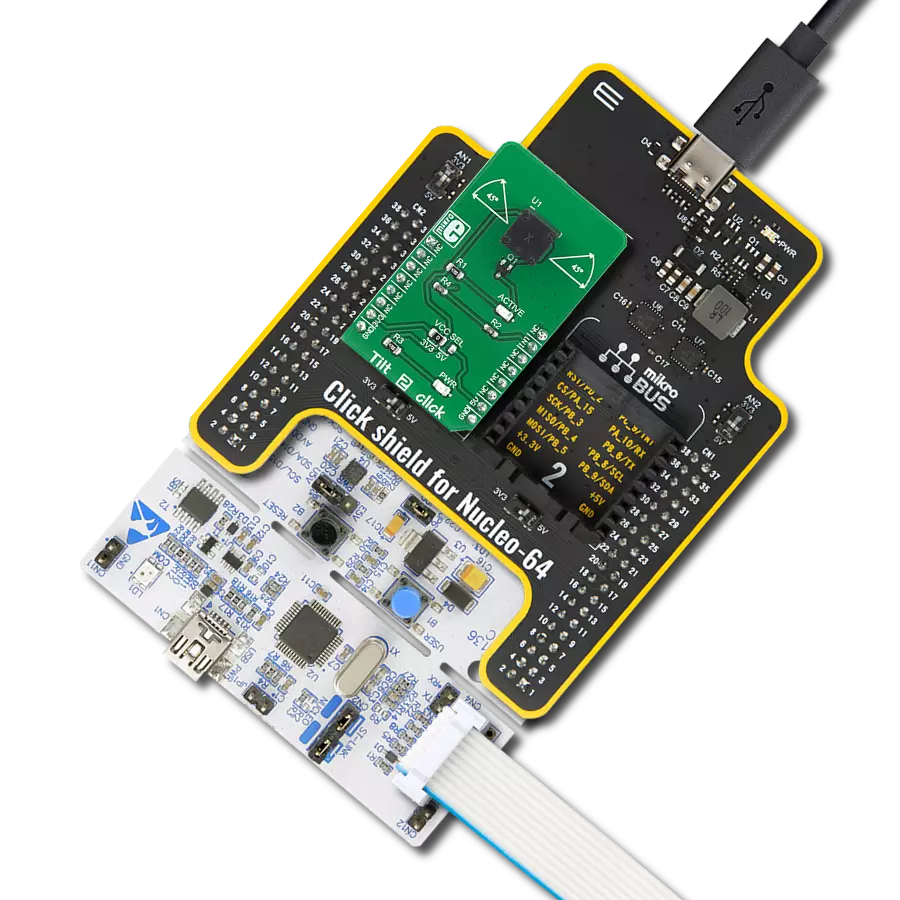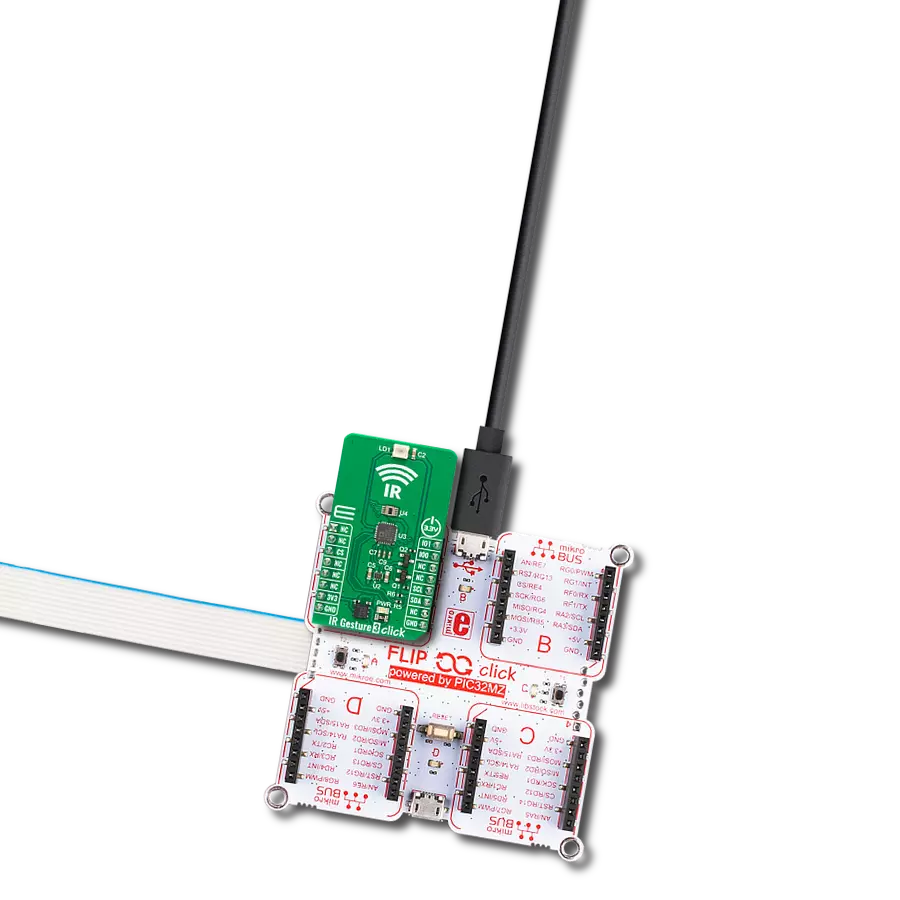6-axis motion sensing ideal for robotic motion tracking, inertial navigation, and UAV stabilization in industrial environments
A
A
Hardware Overview
How does it work?
6DOF IMU 26 Click is based on the SCH16T-K01, a high-performance six-degrees-of-freedom (6DOF) motion sensor from muRata. This device combines a 3-axis gyroscope and a 3-axis accelerometer into a single package, communicating via a digital SPI interface for efficient data transfer. Designed to deliver precision and stability even under demanding conditions, the SCH16T-K01 supports a wide range of configurable options that enhance its adaptability across various applications. The gyroscope offers an in-application selectable measurement range from 300 degrees per second down to 62.5 degrees per second, while the accelerometer supports a selectable range from ±80 m/s² down to ±15 m/s², with a typical default dynamic range of up to ±260 m/s². The sensor also integrates output interpolation and decimation options, allowing flexible data handling and processing tailored to specific needs. The SCH16T-K01 also features adjustable low-pass filters for both angular rate and acceleration, with cut-off
frequencies ranging from 13Hz to 370Hz, ensuring clean signal acquisition even in noisy environments. Built to meet the rigorous AEC-Q100 automotive qualification standard, the SCH16T-K01 is ideal for use in inertial measurement units (IMUs), inertial navigation and positioning systems, dynamic inclination detection, machine control and guidance, robotic platforms, and unmanned aerial vehicles (UAVs), making 6DOF IMU 26 Click a versatile solution for motion tracking in harsh or mission-critical environments. This Click board™ is designed in a unique format supporting the newly introduced MIKROE feature called "Click Snap." Unlike the standardized version of Click boards, this feature allows the main sensor area to become movable by breaking the PCB, opening up many new possibilities for implementation. Thanks to the Snap feature, the SCH16T-K01 can operate autonomously by accessing its signals directly on the pins marked 1-8. Additionally, the Snap part includes a specified and fixed screw hole position,
enabling users to secure the Snap board in their desired location. This Click board™ establishes communication with the host MCU using a 4-wire SPI interface with maximum clock frequency of 10MHz, ensuring reliable and high-speed data transfer. The SPI address of the SCH16T-K01 can be easily configured via onboard jumpers marked ADDR SEL in the Snap area, allowing multiple devices to coexist on the same bus. In addition to the interface pins, the 6DOF IMU 26 Click also uses the RST pin for resetting the SCH16T-K01, and DRY pin as data ready signal that ) outputs an interrupt signal for host MCU when the internal output registers (gyroscope + accelerometer) have been updated. This Click board™ can be operated only with a 3.3V logic voltage level. The board must perform appropriate logic voltage level conversion before using MCUs with different logic levels. It also comes equipped with a library containing functions and example code that can be used as a reference for further development.
Features overview
Development board
Nucleo-64 with STM32G474R MCU offers a cost-effective and adaptable platform for developers to explore new ideas and prototype their designs. This board harnesses the versatility of the STM32 microcontroller, enabling users to select the optimal balance of performance and power consumption for their projects. It accommodates the STM32 microcontroller in the LQFP64 package and includes essential components such as a user LED, which doubles as an ARDUINO® signal, alongside user and reset push-buttons, and a 32.768kHz crystal oscillator for precise timing operations. Designed with expansion and flexibility in mind, the Nucleo-64 board features an ARDUINO® Uno V3 expansion connector and ST morpho extension pin
headers, granting complete access to the STM32's I/Os for comprehensive project integration. Power supply options are adaptable, supporting ST-LINK USB VBUS or external power sources, ensuring adaptability in various development environments. The board also has an on-board ST-LINK debugger/programmer with USB re-enumeration capability, simplifying the programming and debugging process. Moreover, the board is designed to simplify advanced development with its external SMPS for efficient Vcore logic supply, support for USB Device full speed or USB SNK/UFP full speed, and built-in cryptographic features, enhancing both the power efficiency and security of projects. Additional connectivity is
provided through dedicated connectors for external SMPS experimentation, a USB connector for the ST-LINK, and a MIPI® debug connector, expanding the possibilities for hardware interfacing and experimentation. Developers will find extensive support through comprehensive free software libraries and examples, courtesy of the STM32Cube MCU Package. This, combined with compatibility with a wide array of Integrated Development Environments (IDEs), including IAR Embedded Workbench®, MDK-ARM, and STM32CubeIDE, ensures a smooth and efficient development experience, allowing users to fully leverage the capabilities of the Nucleo-64 board in their projects.
Microcontroller Overview
MCU Card / MCU
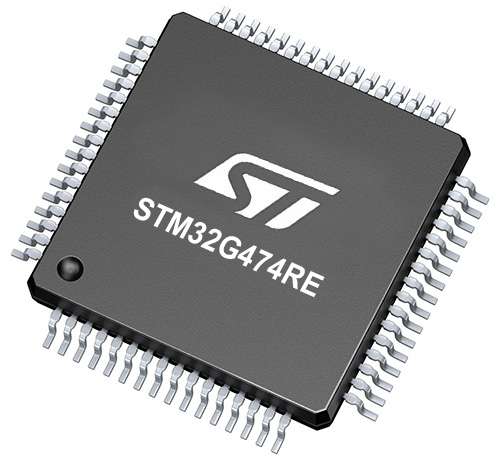
Architecture
ARM Cortex-M4
MCU Memory (KB)
512
Silicon Vendor
STMicroelectronics
Pin count
64
RAM (Bytes)
128k
You complete me!
Accessories
Click Shield for Nucleo-64 comes equipped with two proprietary mikroBUS™ sockets, allowing all the Click board™ devices to be interfaced with the STM32 Nucleo-64 board with no effort. This way, Mikroe allows its users to add any functionality from our ever-growing range of Click boards™, such as WiFi, GSM, GPS, Bluetooth, ZigBee, environmental sensors, LEDs, speech recognition, motor control, movement sensors, and many more. More than 1537 Click boards™, which can be stacked and integrated, are at your disposal. The STM32 Nucleo-64 boards are based on the microcontrollers in 64-pin packages, a 32-bit MCU with an ARM Cortex M4 processor operating at 84MHz, 512Kb Flash, and 96KB SRAM, divided into two regions where the top section represents the ST-Link/V2 debugger and programmer while the bottom section of the board is an actual development board. These boards are controlled and powered conveniently through a USB connection to program and efficiently debug the Nucleo-64 board out of the box, with an additional USB cable connected to the USB mini port on the board. Most of the STM32 microcontroller pins are brought to the IO pins on the left and right edge of the board, which are then connected to two existing mikroBUS™ sockets. This Click Shield also has several switches that perform functions such as selecting the logic levels of analog signals on mikroBUS™ sockets and selecting logic voltage levels of the mikroBUS™ sockets themselves. Besides, the user is offered the possibility of using any Click board™ with the help of existing bidirectional level-shifting voltage translators, regardless of whether the Click board™ operates at a 3.3V or 5V logic voltage level. Once you connect the STM32 Nucleo-64 board with our Click Shield for Nucleo-64, you can access hundreds of Click boards™, working with 3.3V or 5V logic voltage levels.
Used MCU Pins
mikroBUS™ mapper
Take a closer look
Click board™ Schematic

Step by step
Project assembly
Software Support
Library Description
6DOF IMU 26 Click demo application is developed using the NECTO Studio, ensuring compatibility with mikroSDK's open-source libraries and tools. Designed for plug-and-play implementation and testing, the demo is fully compatible with all development, starter, and mikromedia boards featuring a mikroBUS™ socket.
Example Description
This example demonstrates the use of the 6DOF IMU 26 Click board, which provides 3-axis accelerometer and 3-axis gyroscope measurements, as well as temperature data. The example initializes the device and continuously logs sensor readings.
Key functions:
c6dofimu26_cfg_setup- This function initializes Click configuration structure to initial values.c6dofimu26_init- This function initializes all necessary pins and peripherals used for this Click board.c6dofimu26_default_cfg- This function executes a default configuration of 6DOF IMU 26 Click board.c6dofimu26_get_data- This function reads the accelerometer, gyroscope, and temperature data.
Application Init
Initializes the logger and configures the 6DOF IMU 26 Click board. Sets up SPI communication and applies the default configuration.
Application Task
Continuously reads and logs acceleration (g), gyroscope (dps), and temperature (degC) values from the sensor.
Open Source
Code example
The complete application code and a ready-to-use project are available through the NECTO Studio Package Manager for direct installation in the NECTO Studio. The application code can also be found on the MIKROE GitHub account.
/*!
* @file main.c
* @brief 6DOF IMU 26 Click example
*
* # Description
* This example demonstrates the use of the 6DOF IMU 26 Click board, which provides
* 3-axis accelerometer and 3-axis gyroscope measurements, as well as temperature data.
* The example initializes the device and continuously logs sensor readings.
*
* The demo application is composed of two sections:
*
* ## Application Init
* Initializes the logger and configures the 6DOF IMU 26 Click board. Sets up SPI
* communication and applies the default configuration.
*
* ## Application Task
* Continuously reads and logs acceleration (g), gyroscope (dps), and temperature (degC)
* values from the sensor.
*
* @author Stefan Filipovic
*
*/
#include "board.h"
#include "log.h"
#include "c6dofimu26.h"
static c6dofimu26_t c6dofimu26;
static log_t logger;
void application_init ( void )
{
log_cfg_t log_cfg; /**< Logger config object. */
c6dofimu26_cfg_t c6dofimu26_cfg; /**< Click config object. */
/**
* Logger initialization.
* Default baud rate: 115200
* Default log level: LOG_LEVEL_DEBUG
* @note If USB_UART_RX and USB_UART_TX
* are defined as HAL_PIN_NC, you will
* need to define them manually for log to work.
* See @b LOG_MAP_USB_UART macro definition for detailed explanation.
*/
LOG_MAP_USB_UART( log_cfg );
log_init( &logger, &log_cfg );
log_info( &logger, " Application Init " );
// Click initialization.
c6dofimu26_cfg_setup( &c6dofimu26_cfg );
C6DOFIMU26_MAP_MIKROBUS( c6dofimu26_cfg, MIKROBUS_1 );
if ( SPI_MASTER_ERROR == c6dofimu26_init( &c6dofimu26, &c6dofimu26_cfg ) )
{
log_error( &logger, " Communication init." );
for ( ; ; );
}
if ( C6DOFIMU26_ERROR == c6dofimu26_default_cfg ( &c6dofimu26 ) )
{
log_error( &logger, " Default configuration." );
for ( ; ; );
}
log_info( &logger, " Application Task " );
}
void application_task ( void )
{
c6dofimu26_data_t meas_data;
if ( C6DOFIMU26_OK == c6dofimu26_get_data ( &c6dofimu26, &meas_data ) )
{
log_printf( &logger, " Accel X: %.3f g\r\n", meas_data.accel.x );
log_printf( &logger, " Accel Y: %.3f g\r\n", meas_data.accel.y );
log_printf( &logger, " Accel Z: %.3f g\r\n", meas_data.accel.z );
log_printf( &logger, " Gyro X: %.1f dps\r\n", meas_data.gyro.x );
log_printf( &logger, " Gyro Y: %.1f dps\r\n", meas_data.gyro.y );
log_printf( &logger, " Gyro Z: %.1f dps\r\n", meas_data.gyro.z );
log_printf( &logger, " Temperature: %.2f degC\r\n\n", meas_data.temperature );
Delay_ms ( 100 );
}
}
int main ( void )
{
/* Do not remove this line or clock might not be set correctly. */
#ifdef PREINIT_SUPPORTED
preinit();
#endif
application_init( );
for ( ; ; )
{
application_task( );
}
return 0;
}
// ------------------------------------------------------------------------ END
Additional Support
Resources
Category:Motion



















